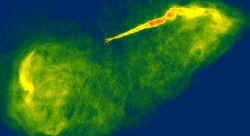Cosmic Ray Puzzle Solved?

Cosmic rays with “ultrahigh” energies plow through the atmosphere thousands of times each day. The origins of these particles–with 100 million times the energies of particles from the most powerful accelerators–are mysterious. Assuming the rays are protons, they can’t travel far without losing energy, and yet nothing in our galactic neighborhood appears to be producing them. Now a pair of physicists suggests in the 17 April PRL that the paradox may result from a long-standing underestimate of the strength of magnetic fields between galaxies. According to their estimates, stronger fields could force an energetic particle to follow a more circuitous route, so its source need not be in a direct line-of-sight from Earth. Sources in any direction could then account for the data.
Astrophysicists have long known that high energy protons tend to interact with photons from the cosmic microwave background and decay into lower energy particles. Barring “exotic” physics, the source of a eV proton must then be within about 50 Mpc (50 megaparsecs, about 150 million light-years), roughly the size of our local supercluster of galaxies. Researchers have usually assumed weak extragalactic magnetic fields in the nG range, so ultrahigh energy cosmic rays (UHECRs) were expected to follow fairly straight paths through space. But nothing within 50 Mpc of Earth and close to the directions of the arriving UHECRs detected so far seems powerful enough to generate them.
Glennys Farrar of New York University and Tsvi Piran of Hebrew University in Jerusalem were surprised to find that little evidence exists for nG fields. Because magnetic fields and charged particles can rotate the polarization of light in a way that depends on frequency, past estimates for extragalactic fields were based on measurements of light polarization rotation from distant quasars. But the standard estimate relied upon an oversimplified model with outdated assumptions, such as a uniform Universe–rather than the void-filled “Swiss cheese” structure accepted today–and a Universe made entirely of ordinary matter (no dark matter or dark energy). “The thing that’s astounding,” says Farrar, “is that over the years the nG estimate became accepted folklore,” partly because theorists didn’t examine it critically and partly because it’s difficult to measure more directly.
Farrar and Piran found that updated assumptions lead to fields that could be much larger–possibly a few tenths of a µG–at least within our supercluster. Such strong fields would deflect a high energy particle significantly and explain why potential UHECR sources rarely line up in the sky with the locations of UHECRs. The team suggests that M87, a so-called active galactic nucleus (AGN) 20 Mpc away, could then account for some or all of the observed UHECRs. M87 and other nearby AGNs could also have been more active in the past, with the particles they spewed out reaching us only after a long delay due to their wandering routes through the supercluster. If most UHECRs do come from M87, the team predicts an asymmetry to emerge in future detections: Slightly fewer UHECRs should arrive in the half of the sky pointing away from M87, and the new Auger detector array under construction in Argentina is well-positioned to test that prediction.
“People have touched on these topics before,” says Todor Stanev of the University of Delaware, but Farrar and Piran make the case “forcefully.” Eugene Loh of the University of Utah agrees: “It’s a good paper to motivate people” to investigate the consequences of the magnetic fields in more detail, he says. Stanev and Loh also agree that real progress on understanding UHECRs will come only after the number of detections is increased dramatically beyond the handful observed to date.


